| Srl | Item |
| 1 |
ID:
161292
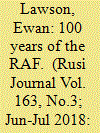

|
|
|
|
|
| Summary/Abstract |
As the RAF celebrates and commemorates the 100th anniversary of its foundation as the world’s first independent air force on 1 April 1918, RUSI marks this event with a special edition of the RUSI Journal. When he established RUSI in 1831, the Duke of Wellington could not have envisaged the multi-domain nature of contemporary military operations, and indeed his great rival Napoleon had disbanded the French military balloon corps some 30 years previously. However, a glance at the archives of the RUSI Journal demonstrates an interest in airpower as part of the military instrument long before the founding of the RAF, with an unsurprising intensification through the First World War. The extent of the continuities as well as the dramatic change in military airpower can be seen in an article from 1914 which discusses the use of aircraft to rapidly remove wounded soldiers from the battlefield.1 In the twenty-first century, this took the form of RAF Chinook helicopters delivering Medical Emergency Response Teams directly to the battlefield in Afghanistan. The articles in this special edition do not seek to review the entire history of the RAF or indeed the military use of airpower, but rather engage with contemporary debates through a range of academic prisms and with insights from academics, practitioners and practitioner-academics.
|
|
|
|
|
|
|
|
|
|
|
|
|
|
|
|
| 2 |
ID:
079200
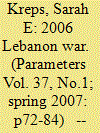

|
|
|
| 3 |
ID:
170247
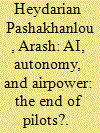

|
|
|
|
|
| Summary/Abstract |
Military pilots have long been central to airpower projection in both combat and non-combat operations. While the historical and contemporary roles of military aviators have been examined extensively in previous scholarship, the present study distinguishes itself by evaluating the future prospects of military aviators. By so doing, it argues that technological advances in autonomy and artificial intelligence (AI) will most likely lead to the development of pilotless aerial vehicles (PAVs), if current technological and social trends persist. In this new order, the military pilot will become a thing of the past.
|
|
|
|
|
|
|
|
|
|
|
|
|
|
|
|
| 4 |
ID:
096544
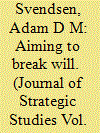

|
|
|
|
|
| Publication |
2010.
|
| Summary/Abstract |
Current US Air Force doctrine emphasizes attacking an enemy's 'will to resist' without defining 'will'. Much of the Air Force's focus on will stems from prewar bombing doctrine and America's initial effort to break an enemy's morale with bombs - the aerial assault on Nazi Germany. That bombing revealed that a nation-state's will to resist actually consists of three distinctive elements - the will of its populace, government leaders, and the armed forces - which together form a collective desire to fight. The bombing also showed that the resilience of the individual components depends on the strength of the bonds that connect them and the war aims pursued by all belligerents. It further illustrated that the individual element most likely to break from air attack is the will of the armed forces.
|
|
|
|
|
|
|
|
|
|
|
|
|
|
|
|
| 5 |
ID:
012770
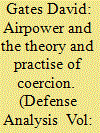

|
|
|
|
|
| Publication |
Dec 1997.
|
| Description |
239-254
|
|
|
|
|
|
|
|
|
|
|
|
|
|
|
|
| 6 |
ID:
142358


|
|
|
| 7 |
ID:
148361
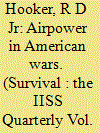

|
|
|
|
|
| Summary/Abstract |
Modern warfare has shown us that actors who lack airpower can contend successfully with the American military.
|
|
|
|
|
|
|
|
|
|
|
|
|
|
|
|
| 8 |
ID:
161296
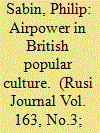

|
|
|
|
|
| Summary/Abstract |
In this article, Philip Sabin surveys how popular images of airpower in Britain, as reflected in books, films and the media, have changed over the past century. It argues that the British public has consistently focused more on the human traumas associated with airpower than on technology and tactics, but that the particular form of this human focus has varied widely over time and is still changing today.
|
|
|
|
|
|
|
|
|
|
|
|
|
|
|
|
| 9 |
ID:
096512
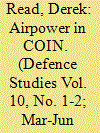

|
|
|
| 10 |
ID:
106780
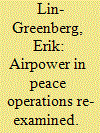

|
|
|
|
|
| Publication |
2011.
|
| Summary/Abstract |
This article examines the role of airpower in peace operations and asserts that, when carried out as part of a multidimensional operation, aviation is a force multiplier that enhances the effectiveness of typically undermanned peace operations forces. Emerging state and commercial actors, even if equipped only with relatively low-tech aircraft, are able to provide intelligence, airlift, information operations and armed support to peace operations. The article examines media reports, academic publications and openly available government and UN documents to assess potential roles for peace operations and to identify political and logistical challenges that must be overcome in deploying airpower.
|
|
|
|
|
|
|
|
|
|
|
|
|
|
|
|
| 11 |
ID:
106064
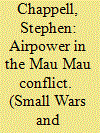

|
|
|
| 12 |
ID:
010325
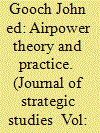

|
|
|
| 13 |
ID:
105600
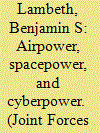

|
|
|
| 14 |
ID:
118200
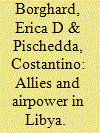

|
|
|
| 15 |
ID:
068266
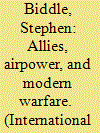

|
|
|
| 16 |
ID:
133874
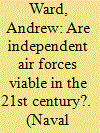

|
|
|
|
|
| Publication |
2014.
|
| Summary/Abstract |
Which modern operations becoming increasingly joint in their nature and airpower now in intrinsic part of every military operation, the need for independent air forces is questioned with special emphasis on the British case
|
|
|
|
|
|
|
|
|
|
|
|
|
|
|
|
| 17 |
ID:
138288


|
|
|
|
|
| Summary/Abstract |
North Atlantic Treaty Organization (NATO) members such as Canada and Denmark have transformed their military forces to better engage in expeditionary warfare. They are incorporating advanced technologies to find and strike targets precisely from great distances at little risk to themselves. The persistence of unmanned aerial vehicles (UAVs) represents the next step in modern airpower’s long-range reconnaissance/precision strike complex and has transformed ground operations. Nonetheless, operational requirements in Afghanistan caught Canada and Denmark flat-footed. Ultimately, Canada effectively used UAVs while Denmark could not. Moreover, neither state has a UAV capability beyond small tactical systems (although each has plans to develop or join in the development of larger ones). The Canadian and Danish experiences suggest that ground forces are most likely to acquire and integrate small UAVs into their force structures and concepts of operation and that the air forces of small- and medium-sized Western countries will likely do so only in cooperation with others. It is here that the Canadian and Danish UAV paths may yet again cross.
|
|
|
|
|
|
|
|
|
|
|
|
|
|
|
|
| 18 |
ID:
115944
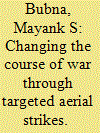

|
|
|
|
|
| Publication |
2013.
|
| Summary/Abstract |
Targeted air strikes remain a cornerstone fighting technique in modern counter-insurgency and other military operations. Yet, scholars and practitioners remain divided on the question of the efficacy of this battle mechanism. This article examines some of the underlying assumptions made in their previous analyses, and serves to nuance those approaches. Specifically, it looks at war, not as a static phenomenon but rather as a constantly evolving environment-one where such aerial campaigns affect insurgent counter-strike capabilities and decisions. Using the USled war in Afghanistan in 2008-09, the article discovers that air strikes limit non-sophisticated counterattacks but are unable to reverse a growing of sophisticated insurgent activity-a discovery that has academic and policy relevant implications.
|
|
|
|
|
|
|
|
|
|
|
|
|
|
|
|
| 19 |
ID:
122551
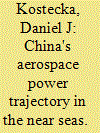

|
|
|
|
|
| Publication |
2012.
|
| Summary/Abstract |
Air and aerospace power has been fundamental for defending China's "near
seas"-encompassing the Bohai Gulf, the Yellow Sea, and the East and South
China Seas-since the founding of the People's Republic.1
While air and naval
operations did not play a significant role in the Chinese Civil War, which was
won by the People's Liberation Army (PLA), the victorious Communist forces
were threatened immediately by hostile air and naval forces from the maritime
sphere. In 1949 the regime was ill equipped to defend its eleven thousand miles
of coastline and more than six thousand islands against attacks and harassment
from Nationalist Chinese air and naval forces occupying the large islands of Taiwan and Hainan, as well as
several smaller islands, let alone protect the People's
Republic of China (PRC) against the aircraft carriers of
the powerful U.S. Seventh Fleet. Even before the People's Republic was officially declared in October 1949,
communist leaders immediately recognized the need
for strong naval and air forces; the PLA's commander,
General Zhu De, stated in April 1949 that China "must
build its own air forces and navy in order to boost
national defense."2
|
|
|
|
|
|
|
|
|
|
|
|
|
|
|
|
| 20 |
ID:
016871
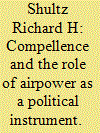

|
|
|
|
|
| Publication |
Jan-March 1994.
|
| Description |
15-27
|
|
|
|
|
|
|
|
|
|
|
|
|
|
|
|